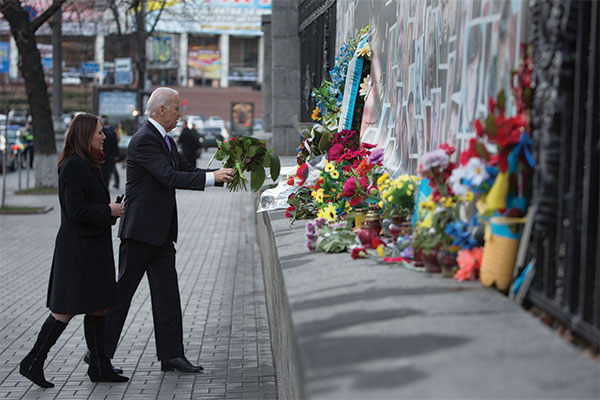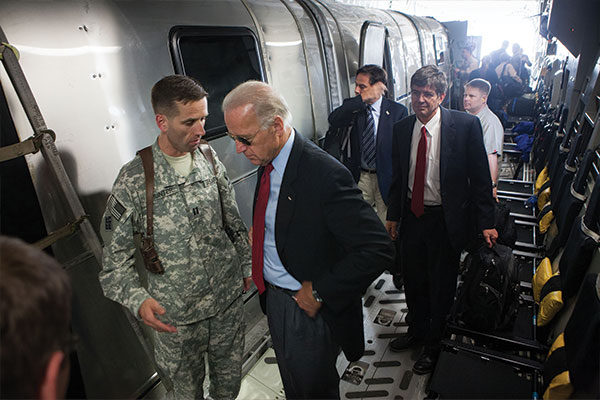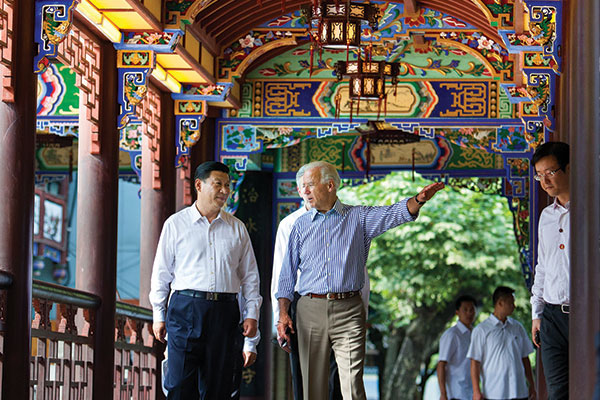Vice President Joe Biden
VP - bio
Joseph Robinette Biden, Jr., represented Delaware for 36 years in the U.S. Senate before becoming the 47th and current Vice President of the United States.
Joseph Robinette Biden, Jr., was born November 20, 1942, in Scranton, Pennsylvania, the first of four siblings. In 1953, the Biden family moved from Pennsylvania to Claymont, Delaware. He graduated from the University of Delaware and Syracuse Law School and served on the New Castle County Council. Then, at age 29, he became one of the youngest people ever elected to the United States Senate.
Just weeks after the election, tragedy struck the Biden family when Biden's wife, Neilia and their one-year-old daughter, Naomi, were killed and their two young sons critically injured in an auto accident. Vice President Biden was sworn in to the U.S. Senate at his sons' hospital bedside and began commuting to Washington every day by train, a practice he maintained throughout his career in the Senate.
In 1977, Vice President Biden married Jill Jacobs. Jill Biden, who holds a Ph.D. in Education, is a life-long educator and currently teaches at a community college in Northern Virginia. The Vice President’s son, Beau, was Delaware's Attorney General from 2007-2015 and a Major in the 261st Signal Brigade of the Delaware National Guard. He was deployed to Iraq in 2008-2009. Beau passed away in 2015 after battling with brain cancer with the same integrity, courage, and strength he demonstrated every day of his life. The Vice President’s other son, Hunter, is an attorney who manages a private equity firm in Washington, D.C. and is Chairman of the World Food Program USA. And his daughter Ashley is a social worker and is Executive Director of the Delaware Center for Justice. Vice President Biden has five grandchildren: Naomi, Finnegan, Roberta Mabel ("Maisy"), Natalie, and Robert Hunter.
As a Senator from Delaware for 36 years, Vice President Biden established himself as a leader in facing some of our nation's most important domestic and international challenges. As Chairman or Ranking Member of the Senate Judiciary Committee for 17 years, then-Senator Biden was widely recognized for his work on criminal justice issues, including the landmark 1994 Crime Act and the Violence Against Women Act. As Chairman or Ranking Member of the Senate Foreign Relations Committee for 12 years, then-Senator Biden played a pivotal role in shaping U.S. foreign policy. He has been at the forefront of issues and legislation related to terrorism, weapons of mass destruction, post-Cold War Europe, the Middle East, and Southwest Asia.
As the 47th Vice President of the United States, Joe Biden has continued his leadership on important issues facing the nation and has represented our country abroad traveling over 1.2 million miles to more than 50 countries. Vice President Biden has convened sessions of the President’s Cabinet, led interagency efforts, and worked with Congress in his fight to raise the living standards of middle class Americans, reduce gun violence, address violence against women, and end cancer as we know it.
VP - Middle Class Economics
Middle Class Economics

Vice President Joe Biden tours the Idora Neighborhood with Assistant Secretary of Commerce for Economic Development, Jay Williams and views homes that were revitalized through funding from the neighborhood stabilization fund at the department of Housing and Urban Development, and the hardest hit fund at the Department of the Treasury, in Youngstown, Ohio, September 1, 2017. (Official White House by David Lienemann)
Eight years ago, the turmoil in the financial sector led to crippling conditions in the real economy -- the livelihood of millions of American households and businesses outside of Wall Street. Eight years later, we’re in the midst of the longest streak of job growth in history -- with more than 15 million jobs added. The Vice President played a key role in acting aggressively to arrest the crisis, restart growth and job creation, rebuild our economy on a stronger long-term foundation, and expand opportunity for all Americans. The Vice President was tasked with implementing and overseeing the $840 billion stimulus package in the American Recovery and Reinvestment Act, which has helped to rebuild our economy and lay the foundation for a sustainable economic future. He fought for America’s auto industry, saving 1.5 million jobs up and down the supply chain. The Vice President also leads the Ready to Work Initiative, the Administration’s key effort to identify opportunities to improve our nation’s workforce skills and training systems to help better prepare American workers for the jobs of a 21st century economy.
Played a Leading Role in Getting the Economy Back on Track
- Chaired the Middle-Class Task Force, which was a guiding force in the Administration’s efforts to improve the livelihoods of middle-class families.
- Oversaw the Administration’s implementation of the Recovery Act -- which added 2 million jobs, helped stave off another Great Depression, and made an unprecedented investment in America’s infrastructure. One of the most efficient government spending programs in history, the Act was determined by the Government Accountability Office -- the gold standard in auditing -- to have waste, fraud, and abuse amount to less than two-tenths of one percent of the total cost of the package.
- Fought for a lifeline for America’s iconic auto industry, saving 1.5 million jobs up and down the supply chain.
- Fought for Congressional approval of the Dodd-Frank, which inserted accountability into the financial sector and fortified the stability of the financial system.
Helped Guarantee Fiscal Policy that Supports Middle-Class Economics
- Led Administration negotiations over tax and spending bill that averted a debt crisis in 2011 and instituted one of the largest deficit-reduction plans in history.
- Secured a legislative compromise at the end of 2012 which averted a fiscal cliff and implemented the largest middle-class tax cut in history.
Training and education
- Led the Administration’s Skills Initiative to improve effectiveness of federal workforce training programs so that more Americans can get the training they need for middle class jobs.
- Oversaw a comprehensive transformation of federal workforce training funding through review of all programs, identification of training strategies that work, and recommendations for practices to be adopted to ensure that federal programs are providing training for skills that employers need and for middle class jobs that are available.
- Fought to prioritize federal support for community colleges as a training provider, and led efforts to incorporate the proven best practice of close alignment between community colleges and employers into all funding programs.
- Recommended greater investment in on-the-job training, particularly apprenticeships, resulting in the greatest increase in the number of apprenticeships in more than a decade.
Fought for a Level Playing Field for American Workers
- Fought for payroll tax cuts during the economic recovery -- ensuring a tax cut for every single worker in America.
- Pushed for a higher national minimum wage, and supported state and city level efforts when Congress failed to agree to a higher national wage floor.
- Was a major proponent of more robust overtime protections, stronger enforcement against companies that collude to hold down wages, and less harmful non-compete restrictions for workers.
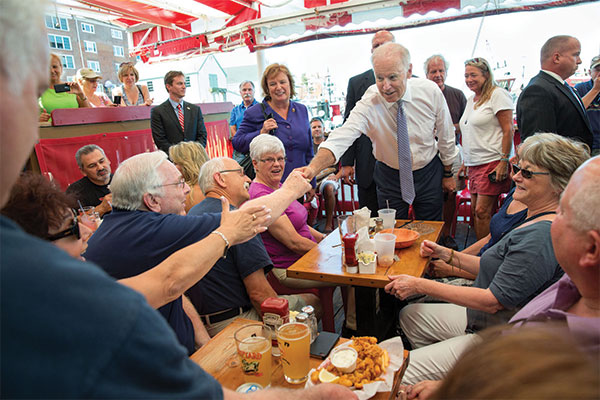

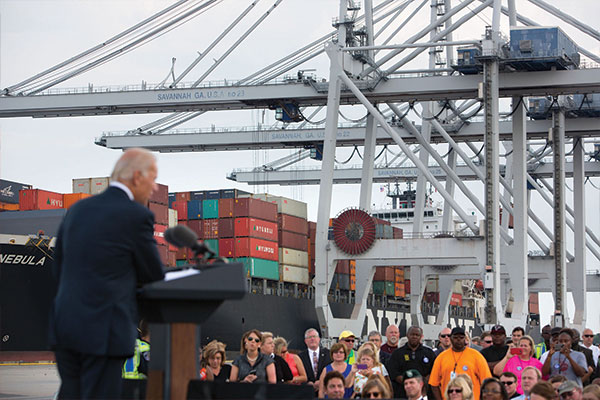
VP - Fighting Violence Against Women
Combatting Violence Against Women

Vice President Joe Biden gives remarks at an "It's On Us" event, in the Schine Student Center on the campus of Syracuse University, in Syracuse, New York, Nov. 12, 2015. (Official White House Photo by David Lienemann)
As the author of the original Violence Against Women Act (VAWA), Vice President Biden has continued to draw upon his years in the United States Senate to address violence against women from the White House -- specifically domestic violence, sexual assault, teen dating violence, and stalking. Not long ago, violence against women was considered a private matter or “family affair” rather than recognized as a crime. Victims often suffered in silence when the court of law and court of public opinion turned a blind eye to a national secret hiding in plain sight. Too often, judges, lawyers, even friends and family blamed the victims instead of the perpetrator. As a senator, the Vice President was convinced that if the curtain was pulled back on this dirty little secret -- the vast majority of the American people would demand change. He and his staff spent thousands of hours researching the legal landscape on domestic violence and meeting with grassroots advocates operating the country’s first battered women’s shelters. They held hundreds of hours of hearings -- with testimony from advocates, health and legal professionals, and brave survivors. After several years as the country began to realize that change was necessary, VAWA was finally enacted into law in 1994. The country made great progress because of it, and the Vice President has continued to tackle the issue of violence against women during this Administration.
Combatting Violence Against Women from the White House
- Vice President Biden announced the appointment of the first-ever White House Advisor on Violence Against Women to support and coordinate national and global efforts to combat domestic violence, sexual assault, and other forms of gender-based violence and serve as a senior advisor to the Vice President on the matters.
- President Obama signed the third reauthorization of VAWA after the Vice President helped break the log jam in the House. The reauthorization of VAWA brought new and enhanced protections for Alaska Native and American Indian women, immigrants, LGBT survivors.
Addressing Campus Sexual Assault
- In April 2011, Vice President Biden, alongside Secretary of Education Duncan, released new guidance to help schools, colleges, and universities respond to sexual assault on campus. The new guidance clarified the legal obligations under Title IX for schools receiving federal funds to respond promptly and effectively to sexual violence.
- In January 2014, the Vice President and President announced the creation of the White House Task Force to Protect Students from Sexual Assault, to be co-chaired by the Vice President’s White House Advisor on Violence Against Women and the Executive Director of the White House Council on Women and Girls.
- Working with federal partners, the White House Task Force to Protect Students from Sexual Assault developed many new resources for use by colleges and universities, including:
- Not Alone: The First Report of the White House Task Force to Protect Students from Sexual Assault. This report contains a checklist for developing a campus sexual misconduct policy, a sample memorandum of understanding for developing a formal relationship between the campus and a local rape crisis center, and sample language for developing a campus policy on reporting and confidentiality.
- The Campus Climate Survey Validation Study (CCSVS). This landmark study by the Department of Justice released in January, 2016, provides data on the prevalence of sexual harassment and sexual assault victimization on nine college/university campuses.
- The Blueprint for Campus Police: Responding to Sexual Assault. The Blueprint, developed by the University of Texas-Austin in response to guidance from the Task Force, serves as a roadmap for campus law enforcement departments seeking to provide a more comprehensive response to sexual assault, including learning about trauma-informed approaches for interacting with sexual assault victims.
- Safe Place to Learn: Prevent, Intercede, and Respond to Sexual Harassment of K-12 Students. This resource package incorporates and emphasizes Title IX satisfaction; trauma sensitivity; and positive school climate.
- Considerations for School District Sexual Misconduct Policies. This document highlights a number of issues that could be particularly helpful for districts to consider when drafting sexual misconduct policies as part of their overall response to sexual misconduct in K-12 schools.
Engaging Men and Boys as Bystanders in Preventing Violence Against Women and Girls
- In September 2014, President Obama and Vice President Biden unveiled It’s On Us, a new campaign to engage students and bystanders in preventing sexual assault. This campaign grew out of meetings convened by the Vice President with sports leagues, media, college-age groups, and others to identify messaging that would reach the millennial demographic.
- It’s On Us features a pledge that anyone can take to commit to standing up against sexual assault. Since its inception, almost 400,000 people have taken the pledge online.
- Vice President Biden delivered It’s On Us remarks at nine colleges and universities around the Nation: The University of Illinois; Clemson University; the Naval Academy; Morehouse College; Ohio State; Syracuse University; the University of Pittsburgh; the University of Nevada Las Vegas; and the University of Colorado at Boulder.
Tackling the Rape Kit Backlog and Modernizing the FBI’s Definition of Rape
- In January 2012, at the urging of Vice President Biden and the White House Council on Women and Girls, the Justice Department modernized the FBI’s definition of rape, which had not been updated since the 1920s. The revised definition covers oral and anal penetration, alcohol/drug facilitated rapes, and rapes of men. Advocates had been working to obtain this change for a decade.
- In March 2015, the Vice President, along with Senator Barbara Mikulski from Maryland, announced the new $41 million Sexual Assault Kit Initiative, which provides funding to help communities accelerate testing of the estimated hundreds of thousands of rape kits that have been backlogged, something the Vice President called an “absolute priority.”
- In September 2015, the Vice President, Attorney General Loretta Lynch, New York District Attorney Cyrus Vance, and actress Mariska Hargitay announced the recipients of federal and state grants to reduce the backlog at an event at the New York City Crime Lab. Through a partnership between the Department of Justice “Sexual Assault Kit Initiative” and the New York County District Attorney’s Office “Sexual Assault Kit Backlog Elimination Program,” over $79 million was given to 43 jurisdictions in 27 states.
Prioritizing Violence Against Women in Our Foreign Policy and National Security
- In 2012, President Obama issued an Executive Order on Preventing and Responding to Violence Against Women and Girls Globally to further enhance the Administration’s efforts to advance the rights and status of women and girls, to promote gender equality in U.S. foreign policy, and to bring about a world in which all individuals can pursue their aspirations without the threat of violence. The Order created an interagency working group co-chaired by the Secretary of State and the Administrator of the U.S. Agency for International Development (USAID), and directed departments and agencies to implement the new United States Strategy to Prevent and Respond to Gender-Based Violence Globally. These actions effectuated the core tenets of the International Violence Against Women Act (I-VAWA) authored by then-Senator Biden.
- In May 2013, President Obama established a team led by the National Security Council (NSC) to respond to sexual assault in the military. The White House Advisor on Violence Against Women worked with the NSC to convene the Health of the Force Working Group and develop new initiatives to assist victims, including the right to a confidential victim advocate. The result of the President and Vice President urging the Department of Defense (DOD) to prioritize this issue, DOD has undergone the most sweeping military justice reform since 1968, including two Executive Orders in 2016 that expanded victims’ rights and implemented statutory mandatory minimum sentences for rape and other sexual assault crimes.
- In October 2016, the Office of the Vice President organized the inaugural meeting of the North American Working Group on Violence Against Indigenous Women and Girls at the White House on October 14, 2016, as part of the outcomes of the North American Leaders Summit with the governments of Mexico and Canada, and led by the continent’s three Attorneys General -- all of whom were women -- to signal that when women come to the table as leaders, the safety of women and girls is given the attention it deserves and recognized as integral to our national and regional security.
The Law Enforcement Response to Violence Against Women
- In March 2013, Vice President Biden and Attorney General Holder announced grants to twelve communities to reduce domestic violence homicides as part of the new Domestic Violence Homicide Prevention Demonstration Initiative (DVHP Initiative).
- In December 2015, the Attorney General announced new guidance on “Identifying and Preventing Gender Bias in Law Enforcement Response to Sexual Assault and Domestic Violence.” The Guidance, which was developed in partnership with police leaders, line officers, detectives, and advocates, states that gender bias is a form of discrimination that may result in law enforcement agencies (LEAs) providing less protection to certain victims on the basis of gender, failing to respond to crimes that disproportionately harm a particular gender, or offering less robust services due to a reliance on gender stereotypes—including those that are based on assumptions or prejudice towards an individual’s gender identity or sexual orientation.
- To support communities putting the Guidance into practice, the Department of Justice recently announced the investment of real money -- over $9 million -- into several new pilot and demonstration programs designed to integrate the principles outlined in the Guidance into actual law enforcement agency policies, training, supervision protocols, and systems of accountability.
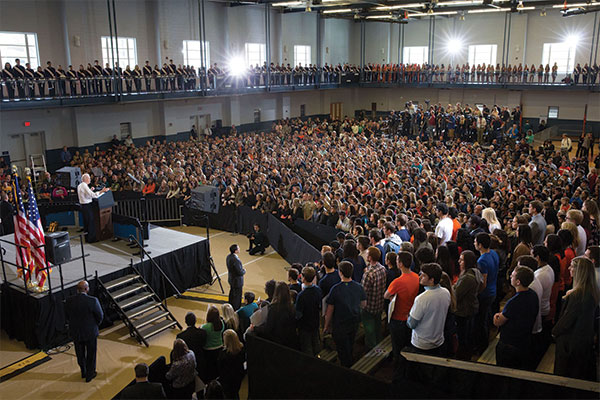
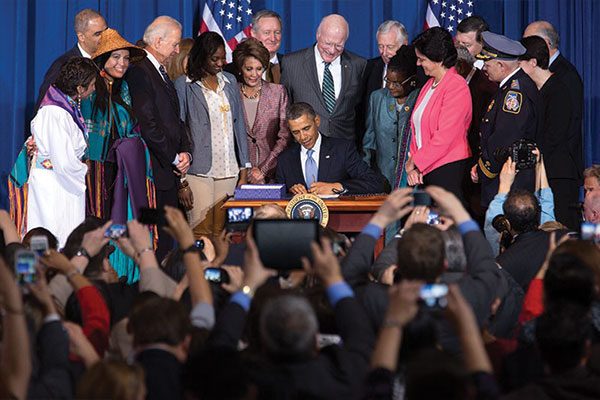
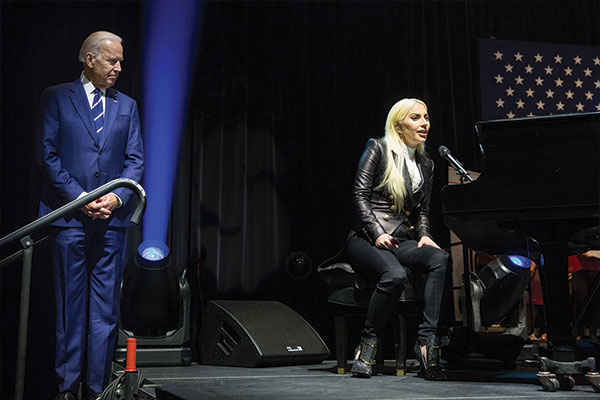
VP - Cancer Moonshot
Cancer Moonshot

Vice President Joe Biden and Dr. Jill Biden tour the Center for Advanced Technology Lab at the University of California San Francisco campus in San Francisco, California, Feb. 27, 2016. Those in attendance are Sam Hawgood, Chancellor of University of California San Francisco; Dr. Alan Ashworth, President, UCSF Helen Diller Family Comprehensive Cancer Center (Tour Guide); Dr. Zev Garner, Associate Professor, Department of Pharmaceutical Chemistry, UCSF (Stop 1). (Official White House Photo by David Lienemann)
In his final State of the Union address, President Obama asked Vice President Biden to head up a new national effort to end cancer as we know it. Here’s the ultimate goal of this Cancer Moonshot: To make a decade’s worth of advances in cancer prevention, diagnosis, and treatment, in five years. And getting it done isn't just going to take the best and brightest across the medical, research, and data communities -- but millions of Americans owning a stake in it, too.
Launching the Cancer Moonshot
- In his 2016 State of the Union address, President Obama called on Vice President Biden to lead a new, national “Cancer Moonshot” to dramatically accelerate efforts to prevent, diagnose, and treat cancer -- to achieve a decade’s worth of progress in five years. By leveraging decades of scientific understanding from the study and care of cancer, creating and aggregating immensely powerful datasets, and developing unprecedented science and technological capabilities, we as a Nation are positioned to end cancer as we know it.
- On January 28, 2016, President Obama issued a Presidential Memorandum establishing the Cancer Moonshot Task Force to bring together all Federal agencies that touch the cancer experience, charged with leveraging Federal investments, targeted incentives, private sector efforts, patient engagement initiatives, and more, to support cancer research and enable progress in prevention, diagnosis, and treatment. Never before have so many government agencies come together -- committing their leadership and uniting their focus -- to tackle the challenges along the spectrum of cancer research and care to improve outcomes for patients.
Working to End Cancer as We Know It
- On June 6, 2016, in support of making research data freely accessible, the Vice President visited the University of Chicago to mark the public release of the National Cancer Institute’s (NCI) Genomic Data Commons (GDC), a first-of-its-kind public data platform for storing, analyzing, and sharing genomic and associated clinical data on cancer. The GDC creates a foundational system for broad sharing and analysis of tumor genome sequences (the DNA unique to cancer cells), which is critical for advancing the field of precision medicine and improving the care of cancer patients, and is designed with appropriate privacy and security protections.
- On June 29, 2016, Vice President Biden convened a Cancer Moonshot Summit at Howard University, in Washington, D.C. More than 400 participants in Washington, D.C. and over 8,000 participants at summits in communities across the country from across the cancer ecosystem -- the private, non-profit, and academic sectors -- came together to discuss how they can contribute to the Cancer Moonshot goals and to announce new commitments to advance cancer research, data sharing, and access to quality cancer care.
- On September 16, 2016, Vice President Biden announced new steps to improve the safety, accessibility and impact of the clinical research system, essential to advancing the progress of the Cancer Moonshot. These steps include (1) making it easier for participants to find clinical trial opportunities as quickly as possible, (2) incentivizing new ways of designing clinical trials to maximize participation while minimizing burden and risk, and (3) strengthening the transparency of clinical trials and trial results. Under the Cancer Moonshot, increasing the efficiency of the clinical research system is a key priority, and these efforts serve ultimately to help speed oncology research toward cancer cures.
- At the United Nation Foundation’s Social Good Summit on September 21, 2016, Vice President Biden announced new international cooperation agreements and investments as part of the Cancer Moonshot. The ten new Memoranda of Understanding/Memoranda of Cooperation for international cancer research and care included new efforts for emerging scientific areas of precision oncology, the funding of collaborative research centers to address cancer disparities in low- and middle-income countries, and a strengthening of existing U.S. bilateral science and technology engagements related to cancer.
- President Obama signed H.R. 34, the 21st Century CURES Act on December 13, 2016. The bill includes $1.8 billion to support the Cancer Moonshot initiative, as well as funding for the President's BRAIN initiative and Precision Medicine initiative. The legislation also commits $1 billion to combat the prescription opioid and heroin epidemic, as well as additional funds to support mental health reform and an improved drug development process. On Monday, December 5, with the Vice President presiding, the bill was amended in the Senate to rename the funding for the Cancer Moonshot in honor of his son, Beau Biden.
Reporting to the American People
- The Blue Ribbon Panel, established per the direction of President Obama and formed under the National Cancer Advisory Board at the National Cancer Institute, National Institutes of Health, presented its report on September 7, 2016. The report identifies major research opportunities that could uniquely benefit from the support of the Cancer Moonshot and lead to significant advances in the understanding of cancer and how to intervene in its initiation and progression, ultimately realizing the Cancer Moonshot’s mission to end cancer as we know it.
- On October 17, 2016, Vice President Biden delivered the Cancer Moonshot report to the President and the American public, summarizing the work of the Cancer Moonshot Task Force since its creation in January, and laying out the Vice President’s strategic plan for transforming cancer research and care. A new set of public and private sector actions and collaborations was also released with the report.
Continuing the Cancer Moonshot
- By the end of this Administration, the Cancer Moonshot will have launched a series of coordinated efforts that incentivize bold, creative, and disruptive approaches to conducting cancer research, promoting prevention, and addressing critical needs for cancer care. These efforts will leverage talent and expertise across disciplines, sectors, and borders and will ensure rapid dissemination of information to the broader cancer research and care community to accelerate progress. Ultimately, these efforts will capitalize and build upon the progress made from the beginning of this Administration to accelerate biomedical research, leverage data and technology, and improve the nation’s access to first-rate, affordable health care. The work of the Cancer Moonshot will continue in the public and private sectors into 2017 through implementation of the many actions and policies developed over the last year.
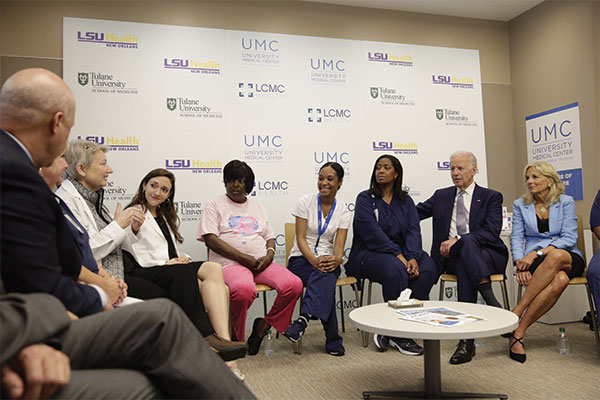
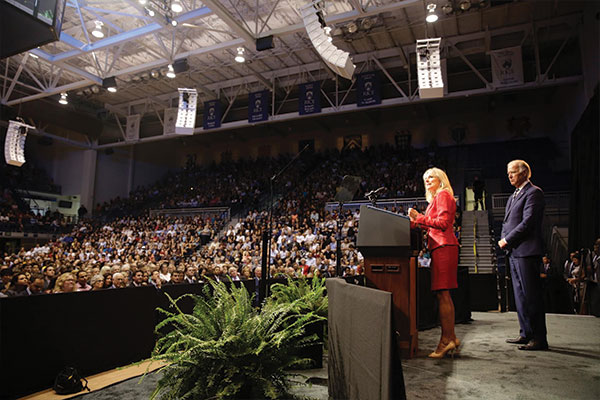
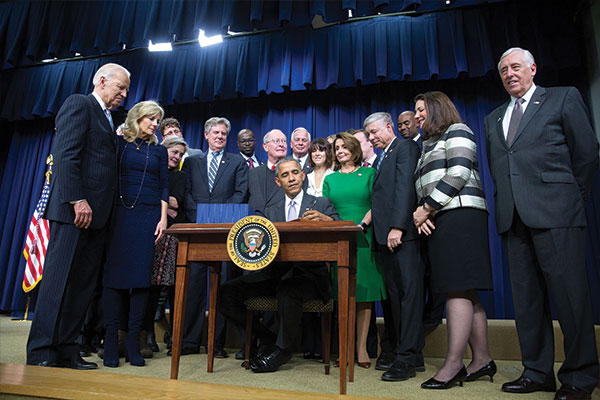
VP - Foreign Policy
Foreign Policy

Vice President Joe Biden awards a Bronze Star to Staff Sgt. Jeremiah Workman at Forward Operating Base Airborne in Wardak Province, Afghanistan, January 11, 2011. (Official White House Photo by David Lienemann)
With decades of foreign policy experience in the U.S. Senate, include serving as Chairman of the Senate Foreign Relations Committee, Vice President Biden advises President Obama on international issues. The Vice President is committed to investing in the foundations of American leadership. That means smart investments in our military, but also ensuring we have a vibrant economy and a tolerant society. We not only lead with the "example of our power" but crucially through the "power of our example." The Vice President believes all politics is personal -- you must really know who you’re sitting across the table from and what his or her political reality is. We must work with international and local partners to share the burden and invest key actors in long-term success. This is key to good policy foreign policy. Demonstrating this belief, the Vice President has represented our country in every region of the world, traveling to more than 50 countries during this Administration.
Encouraging a Hemisphere that is Middle Class, Prosperous, and Secure
Vice President Biden is the Administration’s point person for diplomacy within the Western Hemisphere. He has worked to realize his vision of a Hemisphere that is “middle class, secure, and democratic, from Canada to Chile and everywhere in between.” In this capacity, the Vice President has led the Administration’s regional efforts to address economic, social, governance, and citizen security challenges.
- Made 16 overseas trips in the Western Hemisphere since 2009, including four trips each to Brazil and Mexico, and three each to Canada, Colombia, and Guatemala.
- Launched and chaired the U.S.-Mexico High Level Economic Dialogue, which significantly advanced trade, investment, and border infrastructure between the two countries.
- Worked with the governments of El Salvador, Guatemala, and Honduras to create the Alliance for Prosperity Plan for the Northern Triangle of Central America and engaged with the U.S. Congress to secure $750 million of U.S. support for the region.
- As one of the early supporters of Plan Colombia in the Senate, the Vice President was the first senior U.S. official to travel to Colombia after the Colombian congress ratified the peace accords in December. For his longstanding commitment to Colombia, he was recognized with Colombia's highest national honor by President Juan Manuel Santos, the recipient of the 2016 Nobel Peace Prize.
- Launched the Caribbean Energy Security Initiative in January 2015 and chaired the U.S.-Caribbean-Central America Summit in May 2016, which advanced the diversification and integration of the region's energy sectors.
Standing up for a Europe Whole, Free, and at Peace
The Vice President has been a leading architect of the U.S. strategic vision of a Europe whole, free and at peace. During his time in the Senate, the Vice President led the effort to enlarge NATO to include the former Warsaw Pact countries of Eastern and Central Europe after the collapse of the Iron Curtain. The Vice President’s speech at the Munich Security Conference in February 2015 laid out a vision for how to revitalize NATO, strengthen democratic institutions in Europe, prioritize investments to bolster energy security, and grow trade and investment ties across the Atlantic. The Vice President has been leading the Administration’s effort to support a sovereign, democratic Ukraine, visiting the country three times in 2014.
- Successfully advocated for the release of political prisoners, including Nadia Savchenko of Ukraine and Khadija Ismayilova in Azerbaijan.
- Took leading role in reassuring NATO allies of U.S. commitment to their security after Russia's attempted annexation of Crimea and aggression in eastern Ukraine, including convening a summit with leaders of Estonia, Latvia, and Lithuania in August 2016.
- Was instrumental in securing Montenegro's invitation to join NATO.
- Championed robust and sustained U.S. and international support for Ukraine's political and economic stability and promoted needed reforms.
- Instrumental in securing the Stormont House Agreement in Northern Ireland, which ensured the survival of the independent Northern Ireland Executive and Assembly and a more prosperous future for Northern Ireland.
- Successfully promoted continued regional reconciliation in the Balkans.
- Led U.S. efforts to focus on increasing European energy diversification and security.
Supporting the Rebalance to Asia
The Vice President has also played an active role in supporting the Administration’s rebalance to the Asia-Pacific. He has developed deep relationships with the region’s leaders, demonstrating U.S. commitment to high-level, face-to-face diplomacy.
- Engaged the leadership in both Japan and the Republic of Korea to improve relations among two of the United States’ closest allies, leading to more robust bilateral and trilateral cooperation.
- Developed a constructive dialogue with then-Vice President Xi Jinping during multi-city reciprocal visits to China (August 2011) and the United States (February 2012).
Engaging Iraq and Its Neighbors
In the Middle East, the Vice President has been deeply involved in shaping U.S. policy toward Iraq, visiting the country several times. He has met with the leaders from around the Middle East and has championed Israel’s security.
- Led the effort to promote a unified, federal Iraq and to strengthen the U.S.-Iraqi partnership under the Strategic Framework Agreement.
- Helped broker a new inclusive Iraqi government in 2014 to advance political stability and unity.
- Facilitated dialogue and cooperation between Iraqi and Kurdish leaders to fight ISIL.
- Supported new U.S.-Jordan Memorandum of Understanding increasing U.S. assistance to Jordan up to $1 billion through 2017.
- Engaged regularly with King Abdullah to sustain our vital strategic partnership with Jordan and promote counterterrorism and energy cooperation with regional partners.
Encouraging Economic Integration and Security in the Eastern Mediterranean
- Was instrumental in encouraging the resumption of full diplomatic relations between Turkey and Israel.
- Led U.S. efforts to encourage a Cyprus settlement that would reunify the island as a bi-zonal, bi-communal federation.
